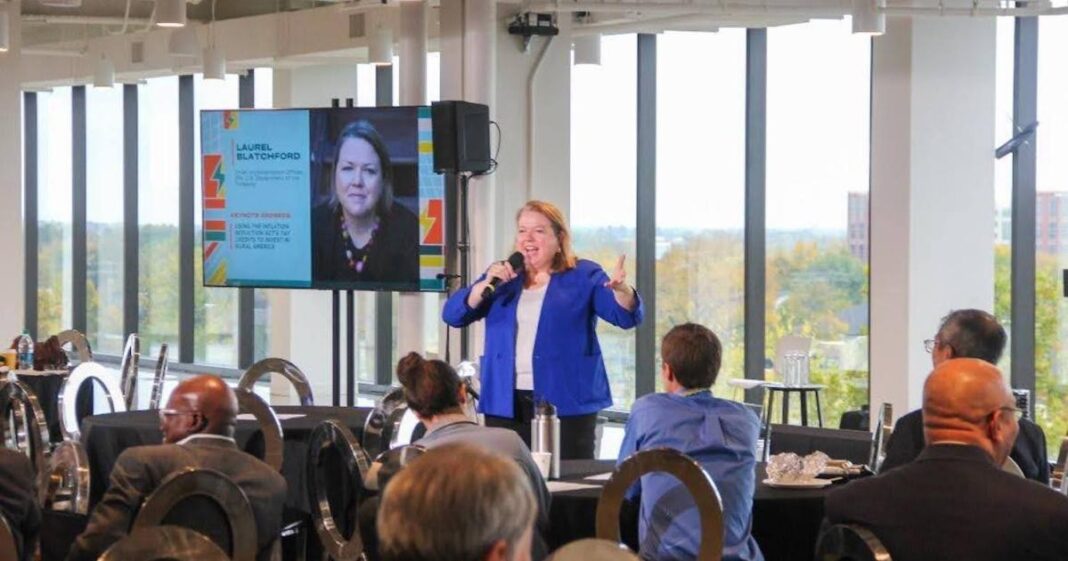The federal government is placing big bets on the leadership role rural communities will play in building resilient clean energy futures, which should be a call to action for the clean energy and corporate sustainability communities. This was clearly illustrated Feb. 27, when the U.S. Department of Energy (DOE) announced more than $366 million in funding for 17 projects across 20 states and 30 tribal nations and communities to accelerate clean energy deployment in rural and remote areas across the country.
Collectively, we are seeing the largest investment in rural power in 100 years, and it will transform the energy landscape and affect the U.S. industrial sector in ways we haven’t seen since the Rural Electrification Act passed in 1936. While the opportunities face headwinds — including rising rural concerns about land use and equitable development alongside surging electricity demand — rural leaders across the country are mobilizing to bring the benefits home.
To coalesce opportunity into action, Groundswell brought rural leaders representing every U.S. region together in Bentonville, Arkansas, in October for the Rural Renaissance Roadshow. Recently deemed a “New Capital of Cool,” Bentonville itself is an example of how purposeful economic development supported by corporate and philanthropic leadership can preserve a small town’s quality of life while supporting growth and attracting amenities such as the world’s first bikeable building — The Ledger — where the Roadshow was held.
Addressing rural energy burdens
While rural communities have ample land, knowledge, talent and other resources needed for clean energy futures, decades of outmigration and extractive development have led to economic decline. Rural cooperative utilities serve more than 92 percent of America’s “persistent poverty counties,” and low-income rural households shoulder energy burdens that are 2-3 times higher than their urban counterparts. Residents in communities with a long history of high poverty rates experience persistent poverty, which often impedes adequate access to infrastructure and support services. This contributes to the prevalence of high energy burdens — defined as high energy costs compared to household income.
Mapping tools such as the Climate and Economic Justice Screening Tool (CJEST) show the prevalence of these issues across America’s Rural South. Rural institutions in these areas — including county and municipal governments and cooperative utilities — are often as under-resourced as the communities and people they serve. Although there is more federal funding flowing to these rural institutions than we’ve seen in generations, rural communities that need the investments the most don’t have the staff or technical expertise to apply for and access the money.
Aiming to connect rural leaders with technical, financial, philanthropic values-aligned business and government resources, the Rural Renaissance Roadshow featured practical workshops on topics ranging from the Inflation Reduction Act (IRA) to how clean energy can support Main Street economic development. Partners and presenters including the Rural Climate Partnership, the Beneficial Electrification League (BEL) and the Milken Institute’s Community Infrastructure Center — which enables project sponsors to create detailed project profiles that automatically match up with every applicable source of federal grants or financing — exemplified the event’s practical, solutions-focused approach.
The biggest investment in rural power in a century
Opening keynote speaker Will McIntee, senior adviser for public engagement at the White House, underscored the scale of what’s at stake with the Bipartisan Infrastructure Law (BIL) and the IRA and highlighted the Rural Partners Network, created specifically to bring whole-of-government resources together in one place for easier access by rural communities.
Among all federal agencies, the U.S. Department of the Treasury has become the single-largest investor in the clean energy economy based on the important role of clean energy and related manufacturing tax credits. During the Roadshow’s closing keynote, Treasury’s chief implementation officer for the Inflation Reduction Act, Laurel Blatchford, led a detailed discussion of the game-changing “elective pay” (also called “direct pay”) tax credit provision, which enables tax-exempt entities including municipalities and rural cooperative utilities to directly receive the value of clean energy tax credits without having to go through an intermediary.
A vision for rural energy futures
Curtis Wynn, CEO of SECO Energy — a large rural cooperative utility serving Central Florida — shared a vision for the role that rural cooperative utilities can play to braid these resources together. Celebrated with the inaugural Rural Power Champion Award, Wynn observed:
“I’ve seen, and I’ve experienced firsthand during my long tenure how America’s electric cooperatives — when intertwined and engaged with other rural partners — can make sizable differences in the communities in which they serve… Today, electric utilities are experiencing a unique combination of both market forces and federal forces driving us toward cleaner and more technologically advanced energy delivery.”
Workshop presentations illuminated dozens of local program and project models that are ripe for scaling through the combination of federal funding and private capital, including equitable community solar development with SharePower in Washington, D.C., agrivoltaic solar development, corporate renewable energy purchasing practices that yield rural energy equity, land use strategies that support regenerative agriculture and keep skies dark and stars visible, and energy resilience planning in Atlanta that prioritizes the needs of residents.
The Roadshow demonstrated that we have the people, ideas and funding resources necessary to build clean energy futures where rural and urban communities can thrive together. Newly empowered rural leaders who gathered for the Roadshow are mobilizing. BIL and IRA, combined with the private capital these federal investments will leverage, will ensure we have the money to make it happen. We’re all in, but much work remains to develop the sustained capacity it will take to turn this moment into momentum.
